 You may have noticed the illuminated symbols on your dashboard when you start your car. While these lights usually go off right away and are soon forgotten, motorists should be car care aware and learn the meaning of their vehicles’ dashboard lights.
You may have noticed the illuminated symbols on your dashboard when you start your car. While these lights usually go off right away and are soon forgotten, motorists should be car care aware and learn the meaning of their vehicles’ dashboard lights.
“Warning lights on the dashboard are simply that, warnings. If one of the lights stays on after you start your car, you could potentially have a problem and should have your vehicle inspected for needed repairs,” said Rich White, executive director, Car Care Council. “By checking your owner’s manual and learning the meaning of each specific dashboard warning light, you’ll be better prepared to take action if one illuminates.”
While dashboard lights may vary by vehicle, the following are examples of common warning lights.
 Check Engine Light
Check Engine Light
The check engine light usually indicates that a vehicle system, such as the ignition, fuel injection or emission control, is not operating properly, even if the vehicle appears to be running normally. A glowing check engine light doesn’t mean you have to immediately pull the car to the side of the road, but it should be inspected as soon as possible. A flashing check engine light requires immediate attention.
Brake System
An illuminated brake system light could mean the parking brake is on, the brake fluid is low, or there is an issue with the anti-lock braking system (ABS). Check to make sure the parking brake is off and have a professional technician check the brake fluid level and diagnose if there is an ABS issue.
TPMS (Tire Pressure Monitoring System)
The TPMS light indicates that a tire has low air pressure or there could be an issue with the sensor. Tire pressure should be checked immediately. Some vehicles will allow manual reset of the TPMS warning light while others may require you to bring the vehicle to a professional service technician to reset it.
Oil Pressure Warning
When the oil pressure warning light stays lit, it indicates loss of oil pressure. Have the oil level and pressure checked immediately.
Battery/Charging Alert
The battery/charging alert indicates that battery voltage level is below normal and the charging system is not functioning properly. Check battery terminals, alternator belt and battery condition.
The Car Care Council is the source of information for the “Be Car Care Aware” consumer education campaign promoting the benefits of regular vehicle care, maintenance and repair to consumers. Visit www.carcare.org for a free copy of the council’s Car Care Guide and for additional information.



















